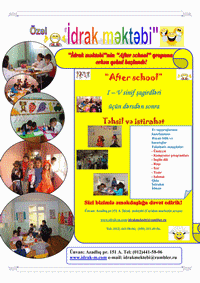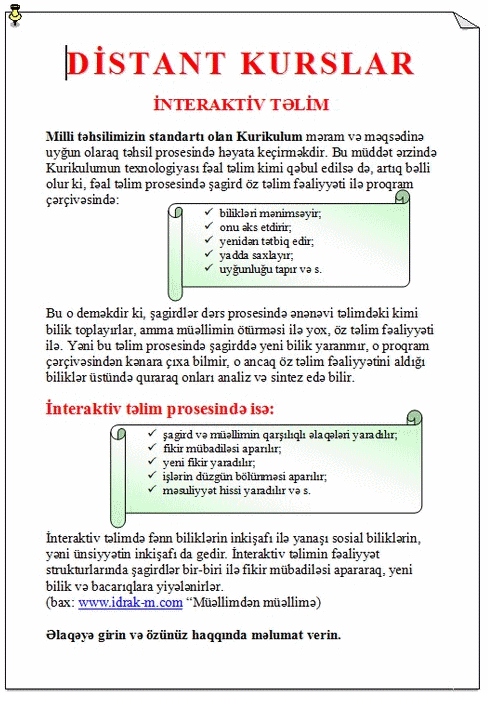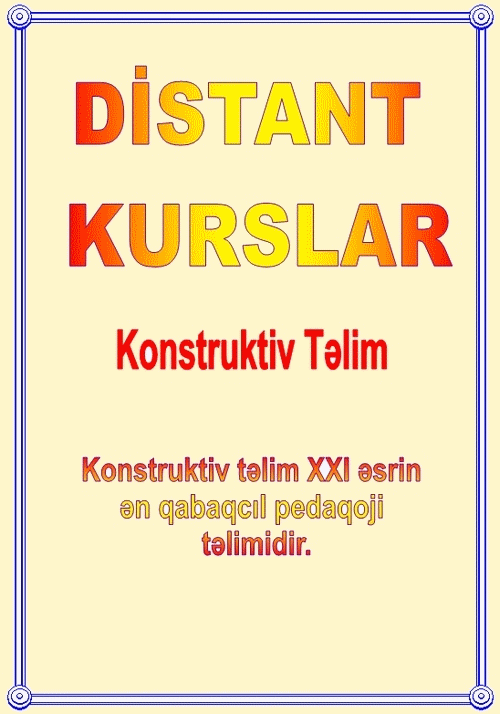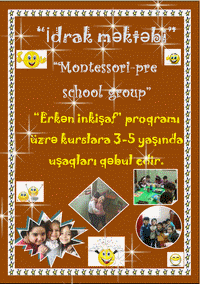ICRES 2017: International Conference on Research in Education and Science THE WAY LEADING FROM THE ADOPTION OF KNOWLEDGE TO CREATION OF KNOWLEDGE AT THE CHEMISTRY CLASSES
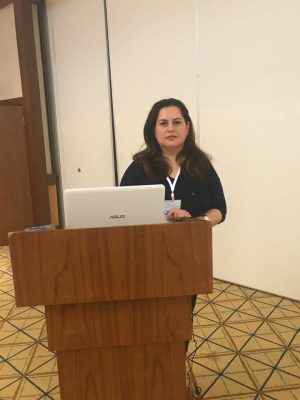 Kamala Tomayeva
Kamala Tomayeva
school 126, Baku, Azerbaijan
tomayevak@gmail.com
Abstract: According to the curriculum programs, basic knowledge of the subject is planned to be taught within
a short period of time. There is weak connection between the topics in the textbooks written on the basis of the
program. Knowledge and skills are not learned systematically, knowledge is transferred in a prepared form make
students to learn them by heart.
A number of changes should be carried out in order to remove this problem and to teach students to be able to
learn by thinking. These include:
The hours for chemistry classes should be increased at incomplete secondary schools. And it will be the
strengthening of forthcoming knowledge.
Textbooks should be written in a simple, meaningful way and knowledge should be associated with each
other systematically.
Practices carried out by the students can yield effective results. While using the Internet resources, the
students have an opportunity to think and to work creatively.
Constructive learning environment should be created in order to rouse interest for the teaching process,
interactive discussions should be organized.
The knowledge presented in the textbook should be compiled in a logical sequence in order to solve the problem.
The given knowledge should be compiled in the modules according to the sections.
As the knowledge within the module is logically linked with each other, the modules are also connected with
each other. Open-ended tests are also given alongside with close-ended tests, along with the knowledge-oriented
questions, thought-provoking questions are also given.
The hermeneutic approach created in constructive atmosphere may result in learning the topic systematically,
learning its parts deep, and acquiring the knowledge is replaced with teaching-learning process.
Keywords: Constructive learning, chemistry classes.
Introduction
Very little time was given to chemistry classes at incomplete secondary schools.
According to the curriculum programs, basic knowledge of the subject is planned to be taught within a short
period of time. There is weak connection between the topics in the textbooks written on the basis of the program.
Knowledge and skills are not learned systematically, knowledge is transferred in a prepared form make students
learn them by heart.
A number of changes should be carried out in order to remove this problem and to teach students to be able to
learn by thinking. These include:
The hours for chemistry classes should be increased at incomplete secondary schools. And it will be the
strengthening of forthcoming knowledge.
Textbooks should be written in a simple, meaningful way and knowledge should be associated with each
other systematically. Alongside with being knowledge- oriented, the tasks should be practical also and
make students to think over them. Thus, students will not learn by heart the course and they will learn the
International Conference on Research in Education and Science (ICRES), May 18 — 21, 2017 Ephesus-Kusadasi/Turkey
77
material. Students will think over how to coordinate, to replace the old knowledge with the new
knowledge and apply practically the new knowledge.
Practices carried out by the students can yield effective results. While using the Internet resources, the
students have an opportunity to think and to work creatively.
Methods
The knowledge presented in the textbook should be compiled in a logical sequence in order to solve the problem.
The given knowledge should be compiled in the modules according to the sections. As the knowledge within the
module is logically linked with each other, the modules are also connected with each other. Open-ended tests are
also given alongside with close-ended tests, along with the knowledge-oriented questions, thought-provoking
questions are alsogiven.
For example: in the 8th grade, in the section “Major classes of in organic compounds”, the following topics –
oxides, bases, acids, and salts are learned without any interrelation. First, brief information about oxides, bases,
acids, salts is given. Then knowledge in each topic is divided into previous and future knowledge: “oxygen
oxides-bases”, “oxides, bases, acids”, and “bases-acids-salts”, “acids-salts-oxides”. The hermeneutic approach
created in constructive atmosphere may result in learning the topic systematically, learning its parts deep, and
acquiring the knowledge is replaced with teaching-learning process.
If it is possible to carry out experiments, it is necessary to work with the students visually. Because visual
experiences are remembered better and they become long-lasting. If there not necessary facilities, it would be
better at least to use the internet resources to get students think and approach a question creatively. If students
carry out experiments by themselves, they will yield more effective results than by using Internet resources.
Example: Oxides should be explained like it: we take three containers for chemical sunstances and place Na2O
into the first one, SO3 into the second one, and CO into the third one. Then the students put wet litmus papers
into each of these containers. The teacher asks questions in logical sequence about the result of the experiment.
Question: What color do the sunstances in the container paint the wet litmus papers?
Answer:. In the first container the litmus paper bocomes blue, in the second container litmus paper bocomes red,
and in the third container litmus paper does not change its color.
Question: Why do you think the color of the litmus papers are changed in the first and second containers, but it
didn’t change its color in the container where CO was placed?
Answer: The substances in the first and in the second containers had mutual effect with the wet litmus papers
because their colors have changed. In the third container, the color of the litmus paper has not changed.
Question: How can you explain the reason of the changes of colors in the first and second container?
The answer to this question was imperfect. The substances in the first and second containers had mutual effect
with, and the substance in the third container was not affected by water.
With these answers, they have shown the outcome of the process, but they were unable to explain the cause of
the process because they had no scientific knowledge about it yet. Because of it, they could not build a new
model of mental knowledge.
The teacher’s supplementary explanation:
When the oxide first container is dissolved in water, the base (NaOH) is formed, when the oxide in the second
container is dissolved in water, acid (H2SO4) is formed. As CO is anoxide that does not generate salt, the color
is unchangable. The following questions are posed in order to link these additions with previous knowledge:
Question: — Which metals in the periodic table of chemical elements are interacting with water generate bases?
Answer: — Alkali metals, alkaline soil metals.
Question: Why are they called alkali?
Answer: — They are dissolved in water; they are chemically active and change the color of the indicator, and so
on.
As we have seen, we did not pass new knowledge to the students. We generated knowledge with the help of
logical questions. In this way, they altered knowledge that they have acquired to the new knowledge.
It is possible to achieve high results by using thought-provoking questions in the learning process.
For example :
Students know the caustic character of the acids as it affects to the human skin. This knowledge can be applied in
another circumstance.
International Conference on Research in Education and Science (ICRES), May 18 — 21, 2017 Ephesus-Kusadasi/Turkey
78
Question: The sculptures made of limestone and marble become corroded within short time in the open air. What
is the reason of this process?
Answer: -Ecological problems, air pollution caused by cars and by gases s chemical plants, dirty rains affect the
sculptures. Especially, the acid contained in the precipitation affects marble and limestone.
The teacher’s supplementary explanation to students’ previous knowledge:
Some gases in the air are transformed into acid in contact with water vapour and falls when it rains. The
sculpture is made of marble or limestone. We know that the content of limestone is CaCO3, which is gradually
corroded by the effect of acid.
An experiment is carried out to get a more effective outcome. We pour distilled water into the chemical glass
and acetic acid into another chemical glass. Then certain fragments of marble are placed in each glass.
After some time, the results in these glasses are compared.
Question: What did you observe in these glasses?
Answer: There was no change in the first glass.
The separation of gas bubbles in the second glass indicates that the chemical process occured and the mass of
marble is reduced.
Another example:
It happened in the 19th century during the cold winter months. The goods train coming from the Netherlands to
Moscow roused interest in everybody. The train was filled with tin beams. Workers at the railway station see that
all the metal became gray dust when the train door was opened. The white color of the tin is transferred to gray
color at temperatures below -13.2 ℃, and this process goes fast at — 33 ℃. If any grain of the gray tin is
interacted with white tin, it is transformed into a gray tin which breaks easily and quickly. It is called “plague of
tin”.
Question: How can you explain the reason of transforming metal into dust accoding to the information given
above?
Answer: In winter, the temperature in Moscow is lower than the modification temperature of the tin, so it
changes the modification of the tin.
Practice: Three different containers are in front of you: there is solution of ethyl alcohol in water(C2H5OH) in
the first container, NaOH (sodium hydroxide) in the second container, and HCl (chloride acid) solution in the
third container. What happens when we conduct an electric current through them?
Answer: In the first container, the lamp does not light, and in the second and third container, lamps light.
Question: Why do the lamps light in two containers and not in the firts one?
Answer: The sunstances in the second and third containers conduct an electric current, while the sunstance in the
first container does not conduct an electric current.
Answers indicate that they respond intuitively, dasedon their own experiences. But they need teacher’s
supplementary scientific explanation.
The teacher: the H + ion separates from the acid and OH-ion separates from the alkali when electric conduct
passes through them. However, not all the substances that contain OH group separate OH-ion. When the ethyl
alcohol is dissolved in water, it does not separate OH-ion.
What is the role of teaching materials used at the chemistry classes? Our primary goal is to research it with
stidents and to realize their knowledge.
For example: “Why are some foods crossed out and does it have any relation with chemistry?”
International Conference on Research in Education and Science (ICRES), May 18 — 21, 2017 Ephesus-Kusadasi/Turkey
79
Responses: — Raw meat is dangerous for life; fizzy drinks react with acid in the stomach; there are glycerine and
acids in the composition of damaged oils that cause poisoning in the stomach; there are a large number of
bacteria in an unboiled the egg; smoked foods are harmful to the child’s organism.
Another example:
In modern vehicles, catalytic converters are used to convert waste gases into gases that are not harmful to the
environment and human beings. At this time, 90% of waste gases are converted to less harmful gases. We can
see this in the table below:
Gases included Gases excluded
Nitrogen ( N2) Nitrogen (N2)
Carbon dioxide ( CO2) Carbon dioxide ( CO2)
Water (steam) H2O Water (steam) H2O
Carbon monoxide (CO) Carbon monoxide (CO) – 10%
Carbon Dioxide (CO2)- 90%
NO , NO2 NO , NO2 -10%
N2- 90%
Question: What coclusion do you draw from this table?
Answer: New substances are generated; some gases do not modify; ew substances were produced; carbon
monoxide was converted into less harmful carbon; our environment is less polluted; NO and 90% of toxic
substances have been converted into inert gas NO2.
Recommendations
Thus, when substituting knowledge-based questions with the thought-provoking questions in the educational
process, students change their learning behaviors and they are also converted from knowledge acquierer into
knowledge creater. Here naturally happens a shift from the acquisition of knowledge to the creation of
knowledge
References
Bunyatova (2007) F.J Konstruktiv təlim: təyini, mahiyyəti.və dərslərdən nümünələr
R.Aliyeva, V.Abbasov ets.(2015) Kimya-8 Derslik
R.Aliyeva, V.Abbasov ets.(2015) Kimya-8, Metodik vesait
http://portal.edu.az/index.php?r=article/blog&id=6&mid=5&lang=az
The Eurasia Proceedings of Educational & Social Sciences (EPESS), 2017
Volume 7, Pages 76-79




